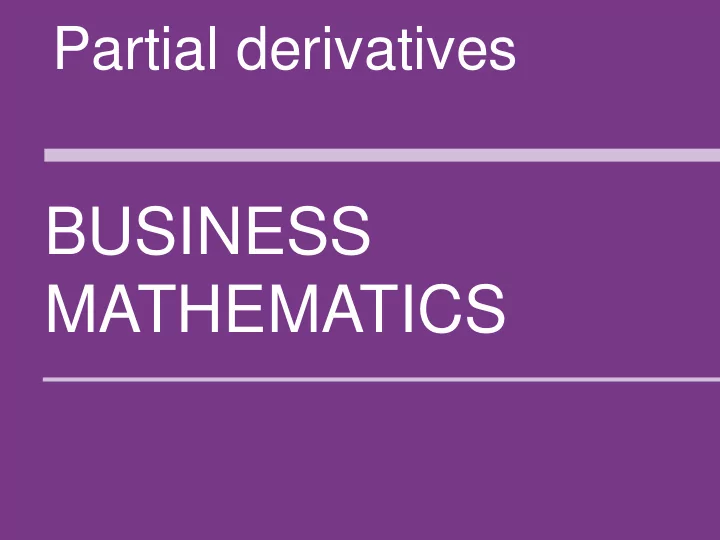

Partial derivatives BUSINESS MATHEMATICS 1
CONTENTS Derivatives for functions of two variables Higher-order partial derivatives Derivatives for functions of many variables Old exam question Further study 2
DERIVATIVES FOR FUNCTIONS OF TWO VARIABLES Can we find the extreme values of a function 𝑦, 𝑧 of two variables 𝑦 and 𝑧 ? ▪ e.g., 𝑦, 𝑧 = 𝑦 3 𝑧 + 𝑦 2 𝑧 2 + 𝑦 + 𝑧 2 Try ′ 𝑦, 𝑧 = ⋯ ▪ this fails! Derivative of a function 𝑔 𝑦 of one variable: 𝑔 ′ 𝑦 = 𝑒𝑔 𝑦 𝑔 𝑦 + ℎ − 𝑔 𝑦 = lim 𝑒𝑦 ℎ ℎ→0 Generalization into partial derivative of 𝑦, 𝑧 of 2 variables: 𝜖 𝑦, 𝑧 𝑦 + ℎ, 𝑧 − 𝑦, 𝑧 = lim 𝜖𝑦 ℎ ℎ→0 3
DERIVATIVES FOR FUNCTIONS OF TWO VARIABLES So differentiate ▪ 𝑦, 𝑧 = 𝑦 3 𝑧 + 𝑦 2 𝑧 2 + 𝑦 + 𝑧 2 with respect to 𝑦 , keeping 𝑧 fixed 𝜖 𝜖𝑦 = 3𝑦 2 𝑧 + 2𝑦𝑧 2 + 1 ▪ and with respect to 𝑧 , keeping 𝑦 fixed 𝜖 𝜖𝑧 = 𝑦 3 + 2𝑦 2 𝑧 + 2𝑧 ▪ 𝜖 𝜖 Clearly, in this case 𝜖𝑦 ≠ 𝜖𝑧 ▪ therefore, never write 𝑔 ′ for a function of two variables! 4
DERIVATIVES FOR FUNCTIONS OF TWO VARIABLES So we define the partial derivative of 𝑔 with respect to 𝑦 𝜖𝑔 𝑦, y 𝑔 𝑦 + ℎ, 𝑧 − 𝑔 𝑦, 𝑧 = lim 𝜖𝑦 ℎ ℎ→0 And similar with respect to 𝑧 𝜖𝑔 𝑦, y 𝑔 𝑦, 𝑧 + ℎ − 𝑔 𝑦, 𝑧 = lim 𝜖𝑧 ℎ ℎ→0 5
DERIVATIVES FOR FUNCTIONS OF TWO VARIABLES 𝜖𝑔 𝑦, 𝑧 𝜖𝑦 𝜖𝑔 𝑦, 𝑧 𝜖𝑧 6
DERIVATIVES FOR FUNCTIONS OF TWO VARIABLES Alternative notations 𝜖𝑔 ▪ 𝜖𝑦 𝜖𝑔 𝑦,𝑧 ▪ 𝜖𝑦 ▪ 𝑔 ′ 𝑦 ▪ 𝑔 ′ Not important to remember, 1 but important to recognize ▪ 𝑔 𝑦 ▪ 𝑔 1 ▪ 𝜖 𝑦 𝑔 so, basically a lot of choice, ▪ etc. but never write 𝑒𝑔 𝑒𝑦 or 𝑔 ′ 7
DERIVATIVES FOR FUNCTIONS OF TWO VARIABLES The partial derivative in a point is a number 𝜖𝑔 𝑦,𝑧 ▪ e.g., 𝑦,𝑧 = 2,−5 = −3 𝜖𝑦 The partial derivative over a range of points is a function of 𝑦 and 𝑧 𝜖𝑔 𝑦,𝑧 ▪ e.g., = 2𝑦 + 3𝑧 − 6 𝜖𝑦 8
DERIVATIVES FOR FUNCTIONS OF TWO VARIABLES Example: Cobb-Douglas production function ▪ decribing how a firm’s output 𝑟 depends on capital input ( 𝐿 ) and labour input ( 𝑀 ) 𝑟 𝐿, 𝑀 = 𝐵 × 𝐿 𝛽 × 𝑀 𝛾 ▪ where 𝐵 , 𝛽 , and 𝛾 are positive constants 𝜖𝑟 Marginal productivity of capital: 𝜖𝐿 𝜖𝑟 𝜖𝐿 = 𝐵 × 𝛽 × 𝐿 𝛽−1 × 𝑀 𝛾 𝜖𝑟 ▪ when 0 < 𝛽 < 1 , 𝜖𝐿 is a decreasing function of 𝐿 ▪ diminishing marginal returns 9
EXERCISE 1 𝜖𝑔 𝜖𝑔 Given is 𝑔 𝑦, 𝑧 = 𝑦 2 𝑓 2𝑧 . Find 𝜖𝑦 and 𝜖𝑧 . 10
EXERCISE 2 𝜖𝑔 𝜖𝑔 Given is 𝑔 𝑦, 𝑧 = 𝑦 𝑧 . Find 𝜖𝑦 and 𝜖𝑧 . 12
HIGHER-ORDER PARTIAL DERIVATIVES Recall the second derivative 𝑒 2 𝑔 𝑦 𝑒 𝑒𝑔 𝑦 = 𝑔 ′′ 𝑦 ▪ = 𝑒𝑦 2 𝑒𝑦 𝑒𝑦 Four possibilities for function 𝑦, 𝑧 : 𝜖 2 𝜖 𝜖 ▪ = 𝜖𝑦 2 𝜖𝑦 𝜖𝑦 𝜖 2 𝜖 𝜖 ▪ 𝜖𝑧 = 𝜖𝑧 2 𝜖𝑧 𝜖 2 𝜖 𝜖 ▪ = 𝜖𝑧 𝜖𝑦 𝜖𝑧𝜖𝑦 𝜖 2 𝜖 𝜖 ▪ 𝜖𝑧 = so, never 𝑒 2 𝑒𝑦 2 or ′′ 𝜖𝑦 𝜖𝑦𝜖𝑧 Alternative notations: 𝜖 2 𝜖 𝑦,𝑧 𝜖𝑦𝜖𝑧 , 𝜖𝑦𝜖𝑧 , ′′ 𝑧𝑦 , ′′ 21 , 𝑧𝑦 , 21 , 𝜖 𝑦𝑧 , etc. ▪ 14
HIGHER-ORDER PARTIAL DERIVATIVES Example: 𝑦, 𝑧 = 𝑦 3 𝑧 + 𝑦 2 𝑧 2 + 𝑦 + 𝑧 2 𝜖 2 𝜖𝑦 2 = 6𝑦𝑧 + 2𝑧 2 ▪ 𝜖 2 𝜖𝑧 2 = 2𝑦 2 + 2 ▪ 𝜖 2 𝜖𝑦𝜖𝑧 = 3𝑦 2 + 4𝑦𝑧 ▪ 𝜖 2 𝜖𝑧𝜖𝑦 = 3𝑦 2 + 4𝑦𝑧 ▪ 𝜖 2 𝜖 2 For almost all functions 𝜖𝑦𝜖𝑧 = 𝜖𝑧𝜖𝑦 ▪ and certainly for all functions we encounter in business and economics 15
EXERCISE 3 𝜖 2 𝑔 Given is 𝑔 𝑦, 𝑧 = 4𝑦 3 𝑧 2 − 3𝑧 4 𝑓 2𝑦 . Find 𝜖𝑦𝜖𝑧 in 𝑦, 𝑧 = −1,0 . 16
HIGHER-ORDER PARTIAL DERIVATIVES Likewise, we can define third-order 𝜖 3 𝑔 𝜖 𝜖 𝜖𝑔 𝑦,𝑧 ▪ = 𝜖𝑦 3 𝜖𝑦 𝜖𝑦 𝜖𝑦 𝜖 3 𝑔 𝜖 𝜖 𝜖𝑔 𝑦,𝑧 ▪ = 𝜖𝑧 2 𝜖𝑦 𝜖𝑧 𝜖𝑧 𝜖𝑦 ▪ how many are there? ▪ how many are different? And even higher-order partial derivatives 𝜖 𝑜 𝑔 ▪ 𝜖𝑦 𝑜 𝜖 𝑜 𝑔 ▪ 𝜖𝑦 𝑜−1 𝜖𝑧 ▪ etc. 18
DERIVATIVES FOR FUNCTIONS OF MANY VARIABLES Let 𝑔 𝑦 1 , 𝑦 2 , 𝑦 3 , … , 𝑦 𝑜 We can form 𝑜 first-order partial derivatives 𝜖𝑔 𝜖𝑔 𝜖𝑔 ▪ 𝜖𝑦 1 , 𝜖𝑦 2 , … , 𝜖𝑦 𝑜 and many many second-order partial derivatives 19
EXERCISE 4 1 𝜖 𝑜 Given is 𝐲 = 𝑦 𝑗 . Find 𝜖𝑦 4 . 𝑜 σ 𝑗=1 20
OLD EXAM QUESTION 27 March 2015, Q1b 22
OLD EXAM QUESTION 22 October 2014, Q1h 23
FURTHER STUDY Sydsæter et al. 5/E 11.1-11.2 Tutorial exercises week 2 partial derivatives higher-order partial derivatives partial derivatives graphically 24
Recommend
More recommend